Page 3012 of 4555
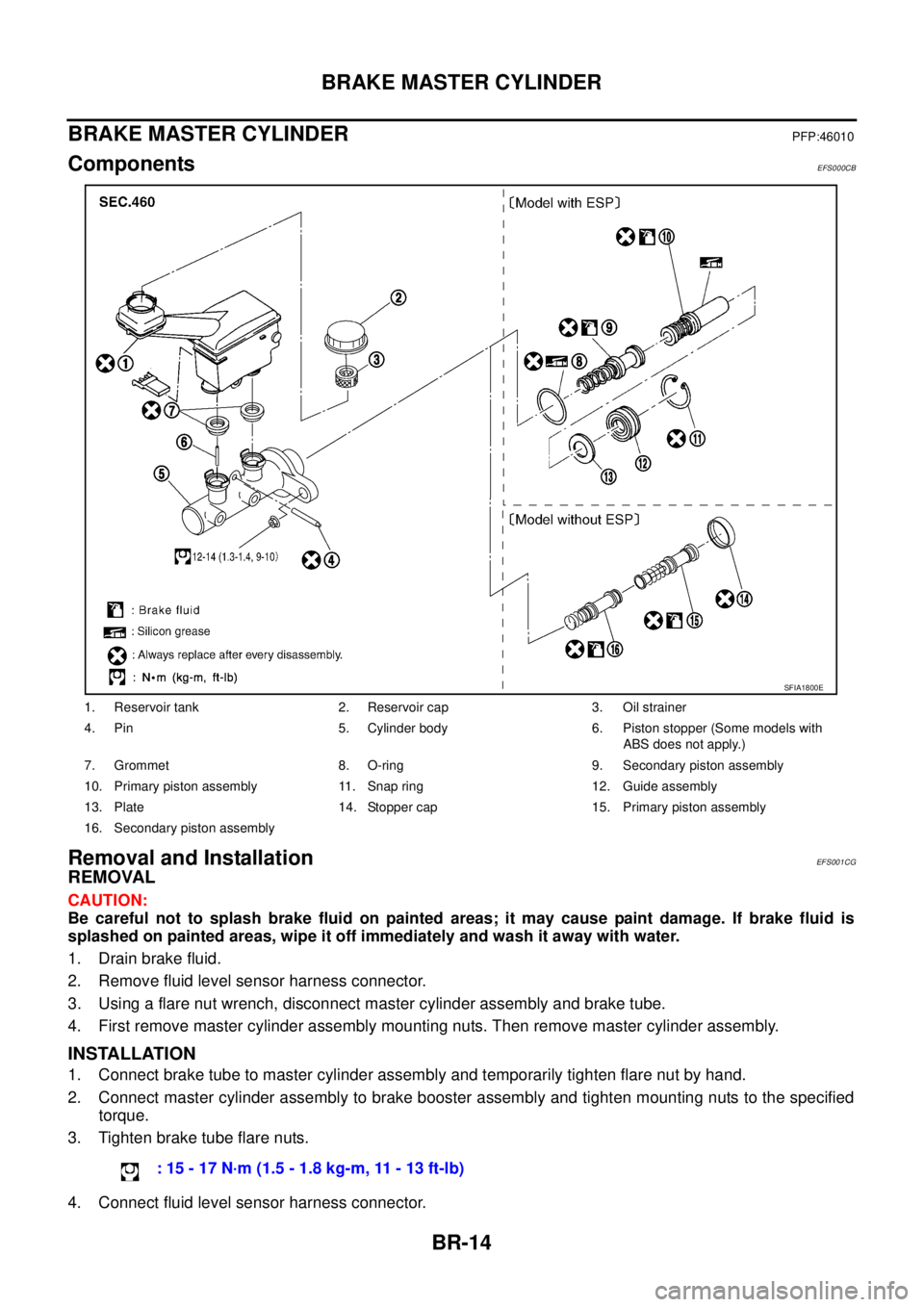
BR-14
BRAKE MASTER CYLINDER
BRAKE MASTER CYLINDERPFP:46010
ComponentsEFS000CB
Removal and InstallationEFS001CG
REMOVAL
CAUTION:
Be careful not to splash brake fluid on painted areas; it may cause paint damage. If brake fluid is
splashed on painted areas, wipe it off immediately and wash it away with water.
1. Drain brake fluid.
2. Remove fluid level sensor harness connector.
3. Using a flare nut wrench, disconnect master cylinder assembly and brake tube.
4. First remove master cylinder assembly mounting nuts. Then remove master cylinder assembly.
INSTALLATION
1. Connect brake tube to master cylinder assembly and temporarily tighten flare nut by hand.
2. Connect master cylinder assembly to brake booster assembly and tighten mounting nuts to the specified
torque.
3. Tighten brake tube flare nuts.
4. Connect fluid level sensor harness connector.
1. Reservoir tank 2. Reservoir cap 3. Oil strainer
4. Pin 5. Cylinder body 6. Piston stopper (Some models with
ABS does not apply.)
7. Grommet 8. O-ring 9. Secondary piston assembly
10. Primary piston assembly 11. Snap ring 12. Guide assembly
13. Plate 14. Stopper cap 15. Primary piston assembly
16. Secondary piston assembly
SFIA1800E
: 15 - 17 N·m (1.5 - 1.8 kg-m, 11 - 13 ft-lb)
Page 3022 of 4555
BR-24
BRAKE BOOSTER
INSPECTION AFTER REMOVAL
Output rod length inspection
1. Using a handy vacuum pump, apply a vacuum of -66.7 kPa (-500 mmHg, -19.69 inHg) to the brake
booster.
2. Check output rod length.
3.
INSTALLATION
1. Loosen lock nut to adjust input rod length so that length “B” (in
the figure) satisfies the specified value.
2. After adjusting “B”, temporarily tighten lock nut to install booster
assembly to vehicle.
3. Connect brake pedal to input rod clevis.
4. Connect brake pedal assembly mounting nuts and tighten to the
specified torque.
5. Connect master cylinder to booster assembly.
6. Adjust brake pedal height and play.
7. Tighten input rod lock nut to the specified torque.
8. Bleed air. Refer to BR-9, "
Bleeding Brake System" . Reference value at vacuum of –66.7 kPa (–500 mmHg,
–19.69 inHg):
Without ESP models : 10.4 mm (0.409 in)
With ESP models : -6.2 mm (-0.244 in)
SBR208E
Length “B” standard : 125 mm (4.92 in)
SGIA0060E
Page 3025 of 4555
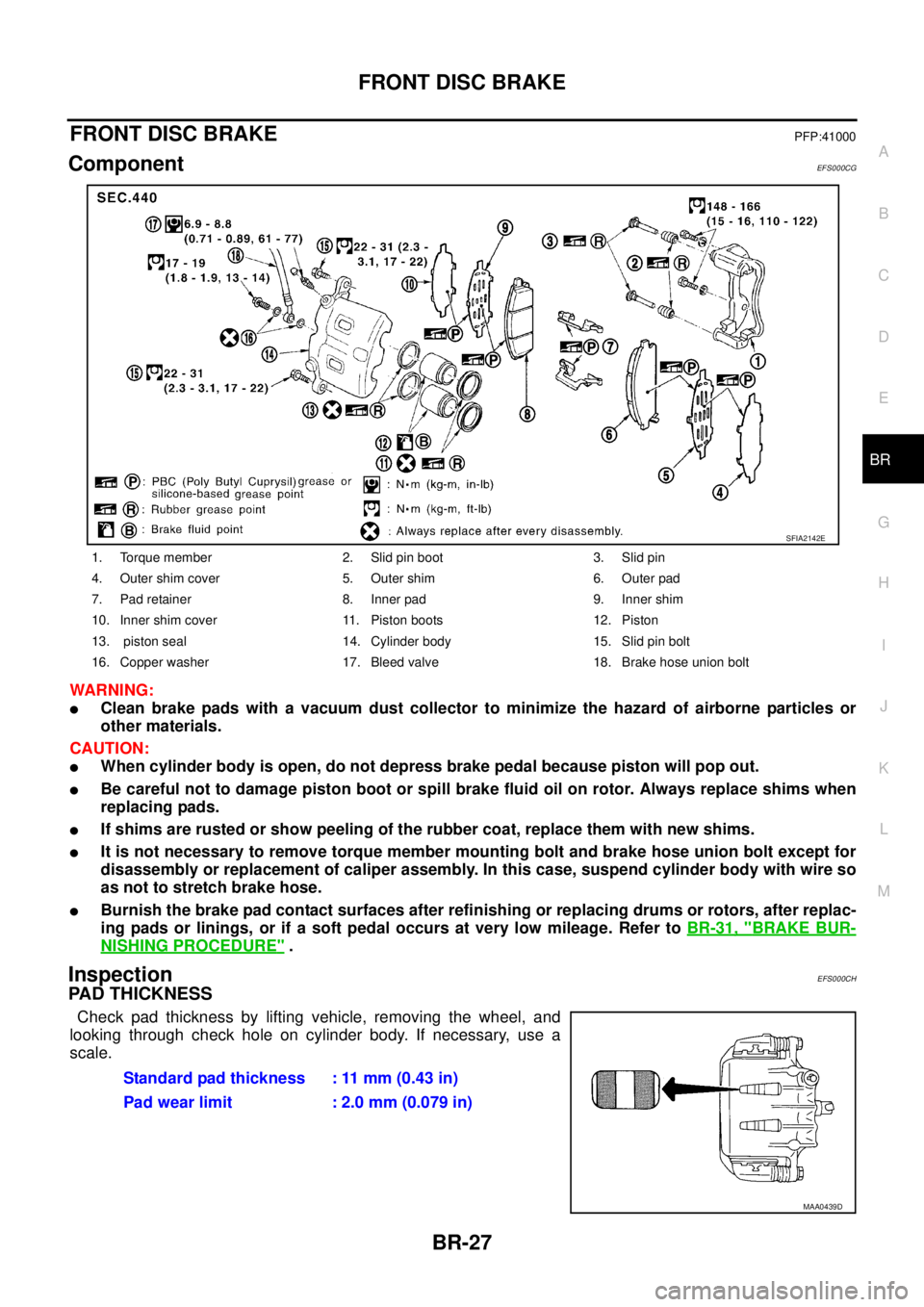
FRONT DISC BRAKE
BR-27
C
D
E
G
H
I
J
K
L
MA
B
BR
FRONT DISC BRAKEPFP:41000
ComponentEFS000CG
WARNING:
�Clean brake pads with a vacuum dust collector to minimize the hazard of airborne particles or
other materials.
CAUTION:
�When cylinder body is open, do not depress brake pedal because piston will pop out.
�Be careful not to damage piston boot or spill brake fluid oil on rotor. Always replace shims when
replacing pads.
�If shims are rusted or show peeling of the rubber coat, replace them with new shims.
�It is not necessary to remove torque member mounting bolt and brake hose union bolt except for
disassembly or replacement of caliper assembly. In this case, suspend cylinder body with wire so
as not to stretch brake hose.
�Burnish the brake pad contact surfaces after refinishing or replacing drums or rotors, after replac-
ing pads or linings, or if a soft pedal occurs at very low mileage. Refer to BR-31, "
BRAKE BUR-
NISHING PROCEDURE" .
InspectionEFS000CH
PAD THICKNESS
Check pad thickness by lifting vehicle, removing the wheel, and
looking through check hole on cylinder body. If necessary, use a
scale.
1. Torque member 2. Slid pin boot 3. Slid pin
4. Outer shim cover 5. Outer shim 6. Outer pad
7. Pad retainer 8. Inner pad 9. Inner shim
10. Inner shim cover 11. Piston boots 12. Piston
13. piston seal 14. Cylinder body 15. Slid pin bolt
16. Copper washer 17. Bleed valve 18. Brake hose union bolt
SFIA2142E
Standard pad thickness : 11 mm (0.43 in)
Pad wear limit : 2.0 mm (0.079 in)
MAA0439D
Page 3026 of 4555
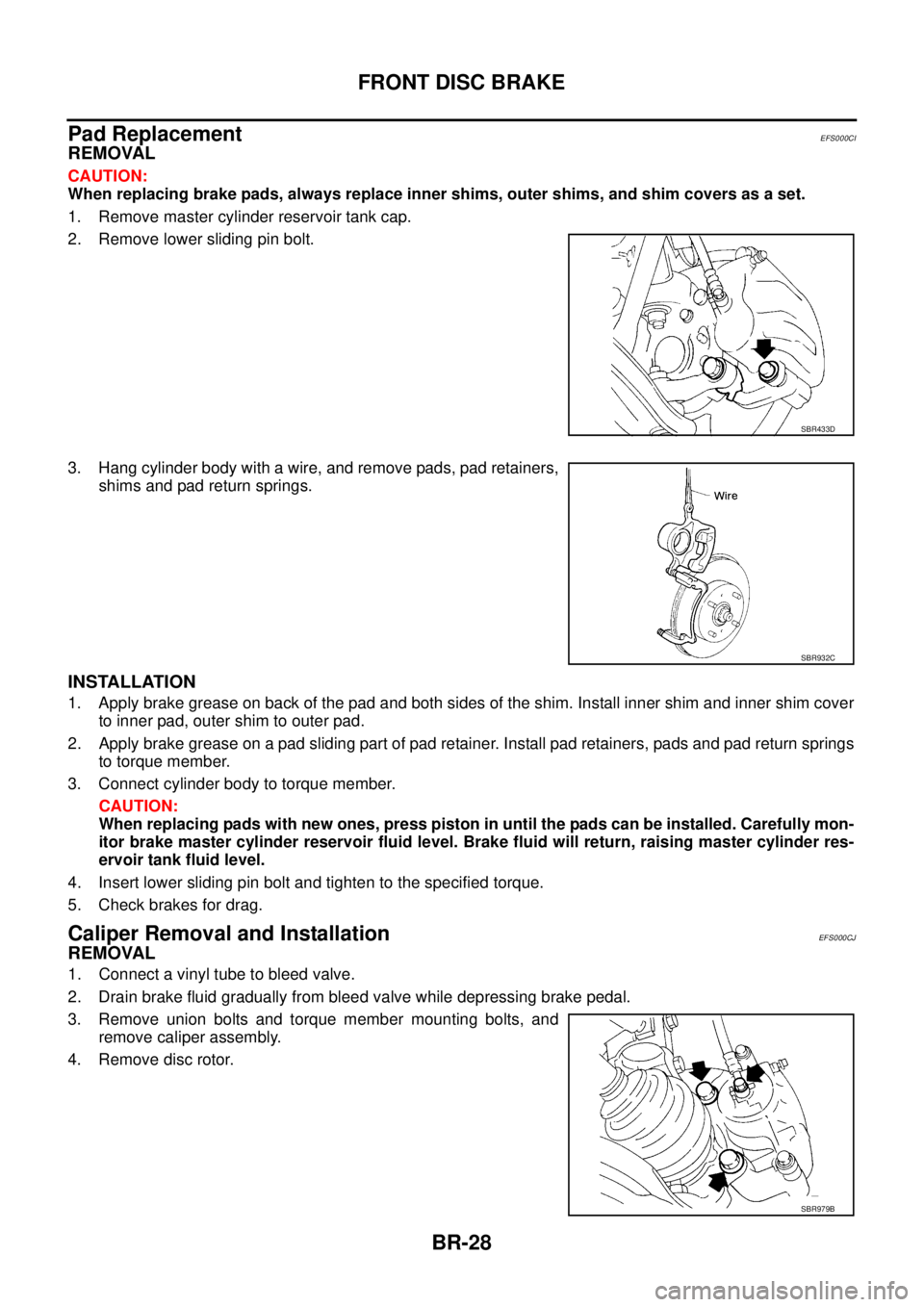
BR-28
FRONT DISC BRAKE
Pad ReplacementEFS000CI
REMOVAL
CAUTION:
When replacing brake pads, always replace inner shims, outer shims, and shim covers as a set.
1. Remove master cylinder reservoir tank cap.
2. Remove lower sliding pin bolt.
3. Hang cylinder body with a wire, and remove pads, pad retainers,
shims and pad return springs.
INSTALLATION
1. Apply brake grease on back of the pad and both sides of the shim. Install inner shim and inner shim cover
to inner pad, outer shim to outer pad.
2. Apply brake grease on a pad sliding part of pad retainer. Install pad retainers, pads and pad return springs
to torque member.
3. Connect cylinder body to torque member.
CAUTION:
When replacing pads with new ones, press piston in until the pads can be installed. Carefully mon-
itor brake master cylinder reservoir fluid level. Brake fluid will return, raising master cylinder res-
ervoir tank fluid level.
4. Insert lower sliding pin bolt and tighten to the specified torque.
5. Check brakes for drag.
Caliper Removal and InstallationEFS000CJ
REMOVAL
1. Connect a vinyl tube to bleed valve.
2. Drain brake fluid gradually from bleed valve while depressing brake pedal.
3. Remove union bolts and torque member mounting bolts, and
remove caliper assembly.
4. Remove disc rotor.
SBR433D
SBR932C
SBR979B
Page 3027 of 4555
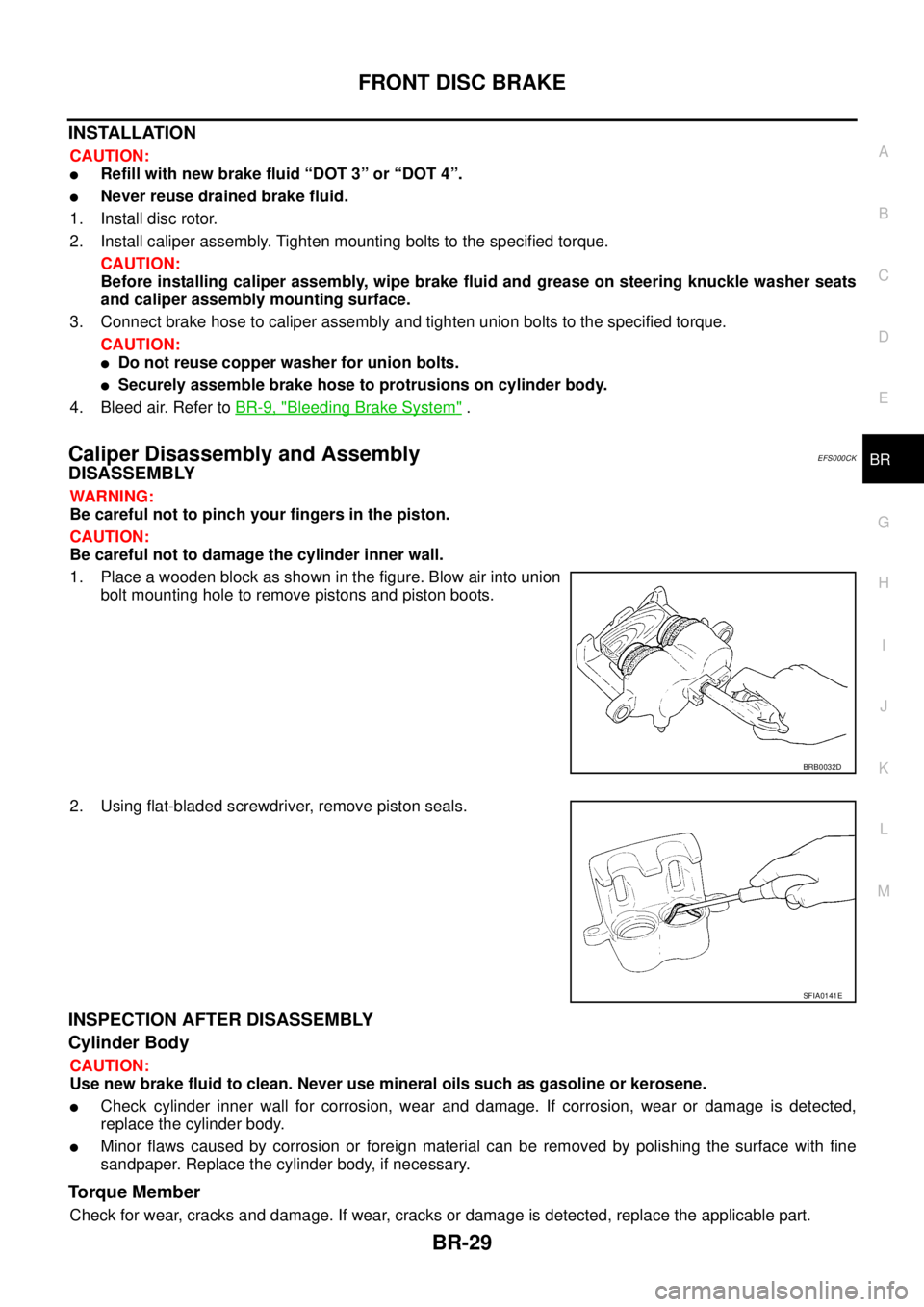
FRONT DISC BRAKE
BR-29
C
D
E
G
H
I
J
K
L
MA
B
BR
INSTALLATION
CAUTION:
�Refill with new brake fluid “DOT 3” or “DOT 4”.
�Never reuse drained brake fluid.
1. Install disc rotor.
2. Install caliper assembly. Tighten mounting bolts to the specified torque.
CAUTION:
Before installing caliper assembly, wipe brake fluid and grease on steering knuckle washer seats
and caliper assembly mounting surface.
3. Connect brake hose to caliper assembly and tighten union bolts to the specified torque.
CAUTION:
�Do not reuse copper washer for union bolts.
�Securely assemble brake hose to protrusions on cylinder body.
4. Bleed air. Refer to BR-9, "
Bleeding Brake System" .
Caliper Disassembly and Assembly EFS000CK
DISASSEMBLY
WARNING:
Be careful not to pinch your fingers in the piston.
CAUTION:
Be careful not to damage the cylinder inner wall.
1. Place a wooden block as shown in the figure. Blow air into union
bolt mounting hole to remove pistons and piston boots.
2. Using flat-bladed screwdriver, remove piston seals.
INSPECTION AFTER DISASSEMBLY
Cylinder Body
CAUTION:
Use new brake fluid to clean. Never use mineral oils such as gasoline or kerosene.
�Check cylinder inner wall for corrosion, wear and damage. If corrosion, wear or damage is detected,
replace the cylinder body.
�Minor flaws caused by corrosion or foreign material can be removed by polishing the surface with fine
sandpaper. Replace the cylinder body, if necessary.
To r q u e M e m b e r
Check for wear, cracks and damage. If wear, cracks or damage is detected, replace the applicable part.
BRB0032D
SFIA0141E
Page 3030 of 4555
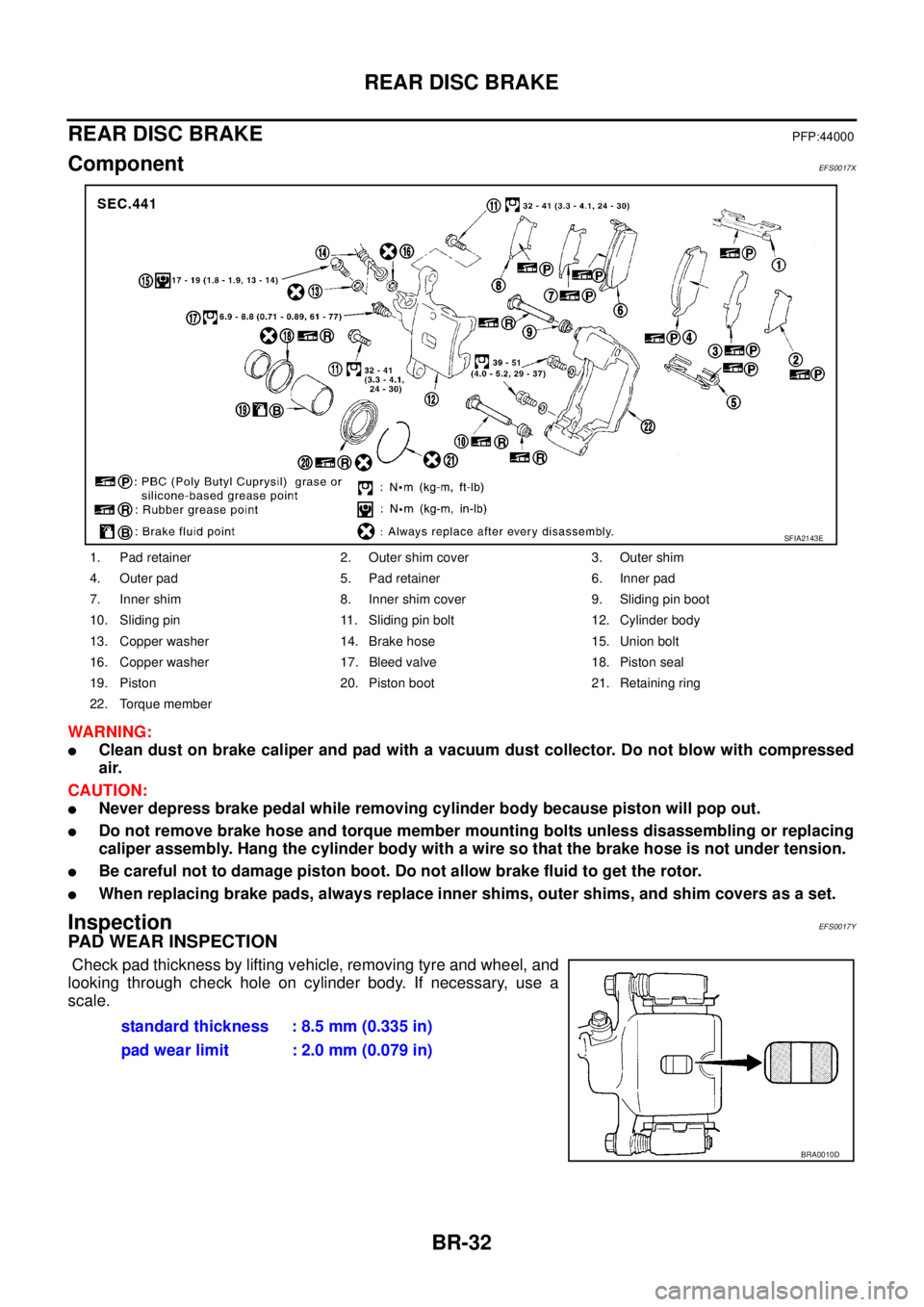
BR-32
REAR DISC BRAKE
REAR DISC BRAKEPFP:44000
ComponentEFS0017X
WARNING:
�Clean dust on brake caliper and pad with a vacuum dust collector. Do not blow with compressed
air.
CAUTION:
�Never depress brake pedal while removing cylinder body because piston will pop out.
�Do not remove brake hose and torque member mounting bolts unless disassembling or replacing
caliper assembly. Hang the cylinder body with a wire so that the brake hose is not under tension.
�Be careful not to damage piston boot. Do not allow brake fluid to get the rotor.
�When replacing brake pads, always replace inner shims, outer shims, and shim covers as a set.
InspectionEFS0017Y
PAD WEAR INSPECTION
Check pad thickness by lifting vehicle, removing tyre and wheel, and
looking through check hole on cylinder body. If necessary, use a
scale.
1. Pad retainer 2. Outer shim cover 3. Outer shim
4. Outer pad 5. Pad retainer 6. Inner pad
7. Inner shim 8. Inner shim cover 9. Sliding pin boot
10. Sliding pin 11. Sliding pin bolt 12. Cylinder body
13. Copper washer 14. Brake hose 15. Union bolt
16. Copper washer 17. Bleed valve 18. Piston seal
19. Piston 20. Piston boot 21. Retaining ring
22. Torque member
SFIA2143E
standard thickness : 8.5 mm (0.335 in)
pad wear limit : 2.0 mm (0.079 in)
BRA0010D
Page 3031 of 4555
REAR DISC BRAKE
BR-33
C
D
E
G
H
I
J
K
L
MA
B
BR
Pad ReplacementEFS0017Z
REMOVAL
CAUTION:
When replacing brake pads, always replace inner shims, outer shims, and shim covers as a set.
1. Remove master cylinder reservoir tank cap.
2. Remove lower sliding pin bolt.
3. Hang cylinder body with a wire, and remove pads, pad retainers,
and shims.
INSTALLATION
1. Apply brake grease on back of the pad and both sides of the shim. Install inner shim and inner shim cover
to inner pad, outer shim to outer pad.
2. Install pad retainers to torque member and install pads.
3. Connect cylinder body to torque member.
CAUTION:
When replacing pads with new ones, press piston in until the pads can be installed. Carefully mon-
itor brake master cylinder reservoir fluid level. Brake fluid will return, raising master cylinder res-
ervoir tank fluid level.
4. Insert lower sliding pin bolt and tighten to the specified torque.
5. Check brakes for drag.
BRB0302D
SBR042C
Page 3032 of 4555
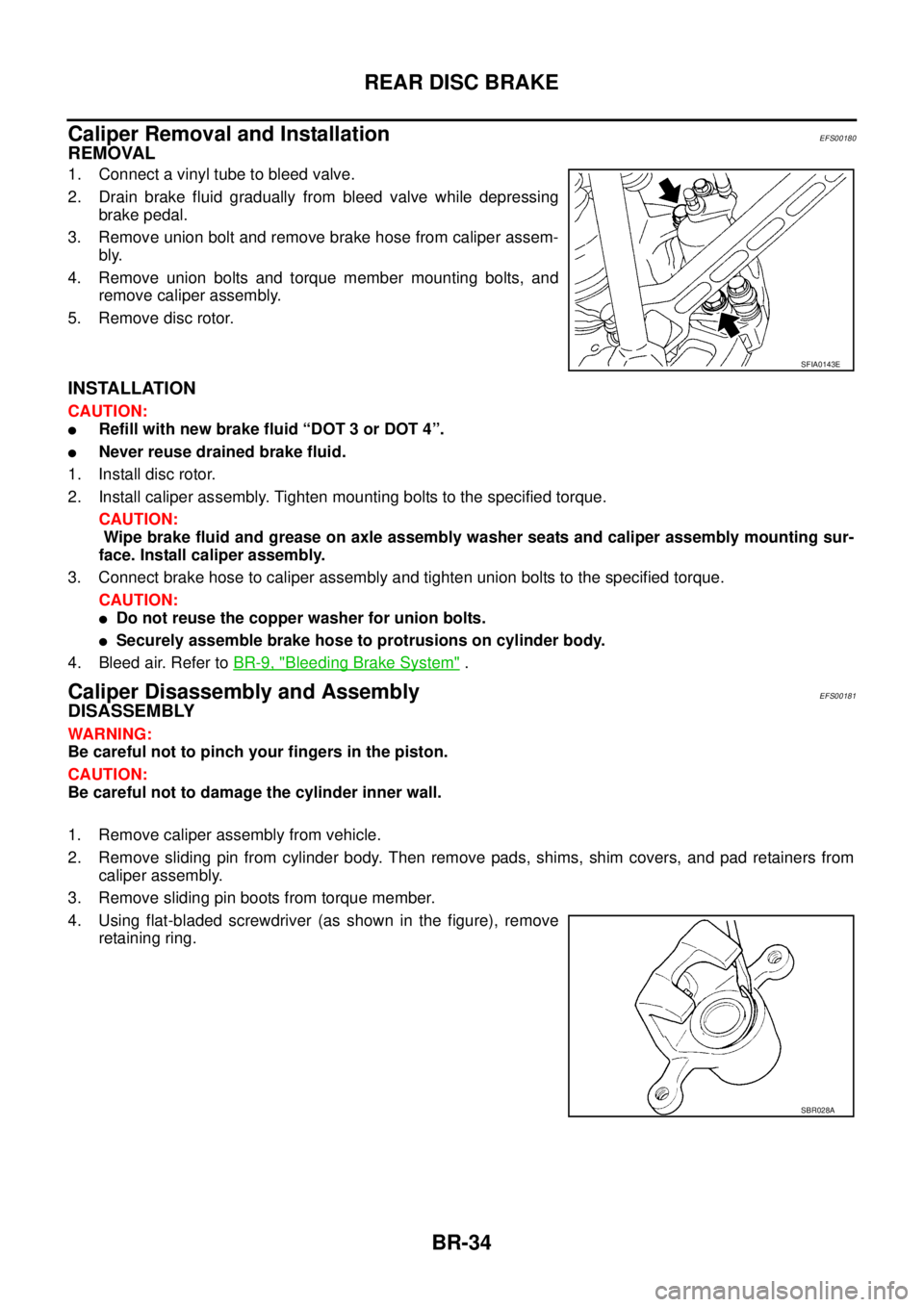
BR-34
REAR DISC BRAKE
Caliper Removal and InstallationEFS00180
REMOVAL
1. Connect a vinyl tube to bleed valve.
2. Drain brake fluid gradually from bleed valve while depressing
brake pedal.
3. Remove union bolt and remove brake hose from caliper assem-
bly.
4. Remove union bolts and torque member mounting bolts, and
remove caliper assembly.
5. Remove disc rotor.
INSTALLATION
CAUTION:
�Refill with new brake fluid “DOT 3 or DOT 4”.
�Never reuse drained brake fluid.
1. Install disc rotor.
2. Install caliper assembly. Tighten mounting bolts to the specified torque.
CAUTION:
Wipe brake fluid and grease on axle assembly washer seats and caliper assembly mounting sur-
face. Install caliper assembly.
3. Connect brake hose to caliper assembly and tighten union bolts to the specified torque.
CAUTION:
�Do not reuse the copper washer for union bolts.
�Securely assemble brake hose to protrusions on cylinder body.
4. Bleed air. Refer to BR-9, "
Bleeding Brake System" .
Caliper Disassembly and AssemblyEFS00181
DISASSEMBLY
WARNING:
Be careful not to pinch your fingers in the piston.
CAUTION:
Be careful not to damage the cylinder inner wall.
1. Remove caliper assembly from vehicle.
2. Remove sliding pin from cylinder body. Then remove pads, shims, shim covers, and pad retainers from
caliper assembly.
3. Remove sliding pin boots from torque member.
4. Using flat-bladed screwdriver (as shown in the figure), remove
retaining ring.
SFIA0143E
SBR028A